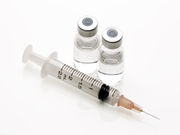Overall, influenza vaccine was 48 percent effective against any influenza illness for 2015 to 2016 season
WEDNESDAY, Aug. 9, 2017 (HealthDay News) — During the 2015 to 2016 season, influenza vaccines reduced the risk of influenza illness, but the live attenuated vaccine was ineffective among children 2 to 17 years of age, according to a study published in the Aug. 10 issue of the New England Journal of Medicine.
Michael L. Jackson, Ph.D., from the Group Health Research Institute in Seattle, and colleagues enrolled patients age 6 months of age or older who presented with acute respiratory illness at ambulatory care clinics. Vaccine effectiveness was estimated using a test-negative design.
The researchers found that 19 percent of the 6,879 eligible participants tested positive for influenza virus, predominantly for A(H1N1)pdm09 and influenza B (11 and 7 percent, respectively). The effectiveness of the influenza vaccine was 48 percent against any influenza illness (95 percent confidence interval [CI], 41 to 55 percent; P < 0.001). The inactivated influenza vaccine was 60 percent effective among children age 2 to 17 years (95 percent CI, 47 to 70 percent; P < 0.001), while the live attenuated vaccine was not effective (vaccine effectiveness, 5 percent; 95 percent CI, −47 to 39 percent; P = 0.80). Among children, vaccine effectiveness against A(H1N1)pdm09 was 63 percent for the inactivated vaccine (95 percent CI, 45 to 75 percent; P < 0.001), compared with −19 percent for the live attenuated vaccine (95 percent CI, −113 to 33; P = 0.55).
“Influenza vaccines reduced the risk of influenza illness in 2015 to 2016,” the authors write. “However, the live attenuated vaccine was found to be ineffective among children in a year with substantial inactivated vaccine effectiveness.”
Copyright © 2017 HealthDay. All rights reserved.








